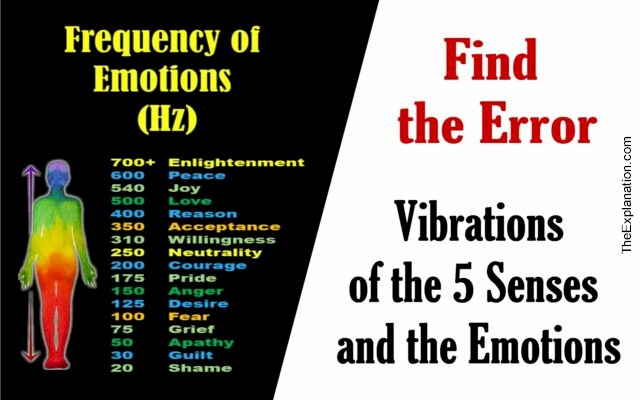Contents
Emotional frequency, real or not? Can you raise or lower the vibrations of emotions?
The book Mind-Body Problem Solved, Chapter 33, explains that vibrations are the surprising common denominator of everything that exists. Both visible and invisible.
(Mind-Body Problem Solved, Chapter 33a – Table of Contents)
This post supplements that chapter with information about emotional frequency and vibrations of the five senses and particularly emotions.
You can order your copy of Mind-Body Problem Solved at TheExplanation.com/mind
Five Senses
The five senses are the primary means humans perceive and interact with the world around them. They are sight, hearing, taste, smell, and touch. Each sense operates through different mechanisms and is associated with specific vibrational frequencies related to the energy of the stimuli they detect. We have already discussed sight, hearing, and smell (Chapter 30), so I will limit this to taste and touch.

The above graph only includes sight (visible) and sound (radio) frequencies. For our three other senses, they are; smell (aromatherapy activates frequency receptors in your nose), taste (the sweetness of sugar associated with a frequency of around 10,000 hertz), and touch (human skin is sensitive to spatial differences at the frequency bands of 1-3 Hz and 18-32 Hz).
Emotional Frequency Vibrations
Emotional vibrations refer to the energy or vibrations associated with different emotional states. Terms like good vibes invoke such sensations. The featured image above refers to such frequencies. The word emotion comes from the French émouvoir, meaning to move. Indeed we are moved in two ways,
- By a conscious mental reaction like love or hate
- By a physiological change, what we call body language
These are two distinct aspects.
- A non-material feeling of sadness or happiness, etc.
- A material bodily reaction such as changes in heart rate, blood pressure, and muscle tension
Science and its instruments can only measure the latter; body, heart, etc. But, regarding feelings and emotions like fear, anger, and euphoria, we can only measure brainwaves corresponding to these excitation states.
That’s the error in the feature image; there is no such thing as frequency, in hertz, of shame, pride, joy, love, or enlightenment. They do reveal changes in brainwaves which science has measured. But these are in the gamma frequency range of 30-150 Hertz. They have nothing to do with the supposed frequencies of the image above.

So where did the idea of an emotional frequency chart come from? It is an arbitrary scale created by Dr. David Hawkins, a psychologist, in his book Force vs. Power. So how did he get to this scale?
It’s an extended mixture of solfeggio dating from ancient Western Gregorian and Eastern Sanskrit chants believed to affect and heal the conscious and subconscious mind. Today, solfege is a seven-tone scale (do, re, mi, fa, sol, la, si) corresponding to specific frequencies said to have therapeutic powers. These frequencies are in tandem with chakras that originated in Buddhist and Hindu practices about 1500 BC and are energy (hence vibrational) centers along the spine that supposedly affect emotional moods.
The scientist Newton associated the solfeggio frequencies with colors surmising they had the same vibrational qualities, which they don’t. Likewise, the Western chakra system gave rise to psychological and other attributes, rainbow colors, and a wide range of supposed correspondences with other so-called spiritual and health promotional methods such as alchemy, astrology, gemstones, homeopathy, Kabbalah, and Tarot.
The lower frequencies relate to negative emotions like shame, with the more noble emotions (love) attached to higher frequencies. This combination amalgamates musical tones with colors to improve health and mental states. Thus, we arrive at Dr. David Hawkins’s research and his Map of Consciousness (the above image is a concise representation), a scale he created for the hidden determinants of human behavior.
The Explanation believes the Bible refers to music having a soothing and healthy mental effect. David played the lyre for King Saul (1 Samuel 16), and music accompanies the Psalms for worshipping God.
On the other hand, monotones, from which we derive the word monotonous, are single frequencies played continuously and are not considered music. Research shows that such monotony can, in fact, adversely affect mood changes and could lead to the development of depression-like traits.
On a real material chart, there’s no such thing as emotional frequency; the best we can do is measure brainwaves that correspond to emotions in the range of about 1-150 Hz.
Dig Deeper into The Explanation
Online Study Courses to Uncover the Mystery of Adam and Eve’s Nakedness… with no fuss. Free video mini-course revealing the God-intended meaning of Scripture via Biblical Hebrew. It’s so easy, it’ll blow you away. Join now and add new motivation to your Bible study.
Join The Explanation Newsletter to stay informed of updates. and future events. No obligations, total privacy, unsubscribe anytime, if you want.
The Explanation series of seven books. Free to read online or purchase these valuable commentaries on Genesis 1-3 from your favorite book outlet. E-book and paperback formats are available. Use this link to see the details of each book and buy from your favorite store.

Since you read all the way to here… you liked it. Please use the Social Network links just below to share this information from The Explanation, Emotional Frequency. Discover The Whole Reality And The Error




You say that “there’s no such thing as emotional frequency” but is this proven? Just because something doesn’t have proof now doesn’t mean it should be thrown away until it does. Back hundreds of years ago they had no proof of gravity or electricity but yet these things are very real.